

API and SDK Documentation. Using Tech Support Mode in ESXi 4.1 and ESXi 5.x. Conquering soapUI. SoapUI is a free and open source desktop application for inspecting and debugging (SOAP-based) web services.
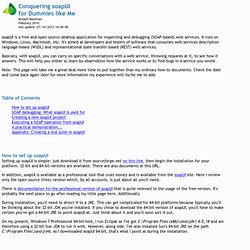
It runs on Windows, Linux, Macintosh, etc. Curl, Mutual Authentication and Web Services « Callista Blog. In a recent project, I was assigned to setup monitoring of a set of web services.

The idea was to call the web services every 5th minute and check whether they operated normally or not, i.e a valid SOAP response was returned. The web services used SSL Mutual Authentication to authenticate the calling client. Since I just wanted to make an easy setup; without invoking a “real” web service client (a Java web service client for instance), I decided to use Curl because of its completeness, available on most platforms, and the ability to easily connect it with Nagios that would perform scheduled checks of the web services. A Gentle Introduction to SOAP.
NoSQL. "Structured storage" redirects here.

For the Microsoft technology also known as structured storage, see COM Structured Storage. A NoSQL (often interpreted as Not Only SQL[1][2]) database provides a mechanism for storage and retrieval of data that is modeled in means other than the tabular relations used in relational databases. Motivations for this approach include simplicity of design, horizontal scaling and finer control over availability. The data structure (e.g. key-value, graph, or document) differs from the RDBMS, and therefore some operations are faster in NoSQL and some in RDBMS. There are differences though, and the particular suitability of a given NoSQL DB depends on the problem it must solve (e.g. does the solution use graph algorithms?). History[edit] CouchDB. Apache CouchDB, commonly referred to as CouchDB, is an open source database that focuses on ease of use and on being "a database that completely embraces the web".[1] It is a NoSQL database that uses JSON to store data, JavaScript as its query language using MapReduce, and HTTP for an API.[1] One of its distinguishing features is multi-master replication.

CouchDB was first released in 2005 and later became an Apache project in 2008. Unlike in a relational database, CouchDB does not store data and relationships in tables. Instead, each database is a collection of independent documents. JSON. JSON (/ˈdʒeɪsən/ JAY-sən),[1] or JavaScript Object Notation, is an open standard format that uses human-readable text to transmit data objects consisting of attribute–value pairs.

It is used primarily to transmit data between a server and web application, as an alternative to XML. Although originally derived from the JavaScript scripting language, JSON is a language-independent data format. Code for parsing and generating JSON data is readily available in many programming languages. The JSON format was originally specified by Douglas Crockford. It is currently described by two competing standards, RFC 7159 and ECMA-404.
History[edit] MongoDB. MongoDB (from "humongous") is a cross-platform document-oriented database.
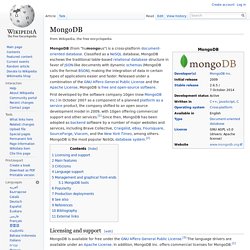
Classified as a NoSQL database, MongoDB eschews the traditional table-based relational database structure in favor of JSON-like documents with dynamic schemas (MongoDB calls the format BSON), making the integration of data in certain types of applications easier and faster. Released under a combination of the GNU Affero General Public License and the Apache License, MongoDB is free and open-source software. First developed by the software company 10gen (now MongoDB Inc.) in October 2007 as a component of a planned platform as a service product, the company shifted to an open source development model in 2009, with 10gen offering commercial support and other services.[1] Since then, MongoDB has been adopted as backend software by a number of major websites and services, including Brave Collective, Craigslist, eBay, Foursquare, SourceForge, Viacom, and the New York Times, among others. Chef Cookbook: mongodb - Opscode Community. Installs and configures MongoDB, supporting: Single MongoDBReplicationShardingReplication and Sharding10gen repository package installation10gen MongoDB Monitoring System This cookbook depends on these external cookbooks aptpythonrunityum Platform: The cookbook aims to be platform independent, but is best tested on debian squeeze systems.
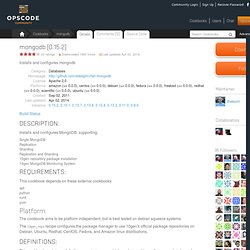
The 10gen_repo recipe configures the package manager to use 10gen's official package repositories on Debian, Ubuntu, Redhat, CentOS, Fedora, and Amazon linux distributions. Amazon Web Services. AWS Management Console. With Resource Groups, you can view collections of resources that share common tags.
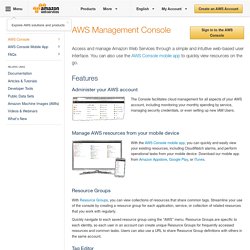
Streamline your use of the console by creating a resource group for each application, service, or collection of related resources that you work with regularly. Quickly navigate to each saved resource group using the “AWS” menu. Resource Groups are specific to each identity, so each user in an account can create unique Resource Groups for frequently accessed resources and common tasks. Users can also use a URL to share Resource Group definitions with others in the same account. Use the Tag Editor to easily manage tags for all resource types that support tags in any region. We are eager to hear about your user experience with the AWS Management Console. Amazon EC2, Apache, MySQL, PHP, and Tomcat 7 Tutorial for Laura. Amazon Elastic Compute Cloud. Amazon Elastic Compute Cloud (EC2) is a central part of Amazon.com's cloud computing platform, Amazon Web Services (AWS).
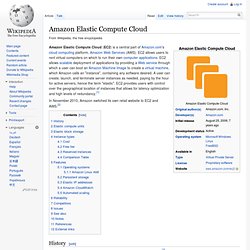
EC2 allows users to rent virtual computers on which to run their own computer applications. EC2 allows scalable deployment of applications by providing a Web service through which a user can boot an Amazon Machine Image to create a virtual machine, which Amazon calls an "instance", containing any software desired. A user can create, launch, and terminate server instances as needed, paying by the hour for active servers, hence the term "elastic". Welcome. Amazon Elastic Compute Cloud (Amazon EC2) provides scalable computing capacity in the Amazon Web Services (AWS) cloud.

Using Amazon EC2 eliminates your need to invest in hardware up front, so you can develop and deploy applications faster. You can use Amazon EC2 to launch as many or as few virtual servers as you need, configure security and networking, and manage storage. Amazon EC2 enables you to scale up or down to handle changes in requirements or spikes in popularity, reducing your need to forecast traffic. For more information about cloud computing, see What is Cloud Computing? Amazon S3 – The Beginner’s Guide. Few days ago, I was still struggling with solution to further scale this blog so it will serve contents faster and at the same time, not pressuring the server too hard. Hongkiat.com serves about 50,000 pageviews daily and that consumed about 60-80Gb of bandwidths on a daily basis. Something have to be done here so the requesting of images and files will not affect the stability of the entire server. After some readings, considerations and research, I settle for Amazon S3.
You might have heard of it, or perhaps using it already. JVM Troubleshooting Tools. JVM Troubleshooting Tools This chapter tutorial notes on JVM troubleshooting tools. Topics include 'jinfo' to check JVM option values, 'jstack' to dump stack traces and detect deadlocks, 'jmap' to print heap histogram and dump heap files, 'jhat' to browse head files and run OQL queries. JVM Troubleshooting Tools in JDK 1.5'jinfo' - VM Option Value CheckerChanging HotSpot VM Option using 'jinfo''jstack' - Stack Tracer of JVM ThreadsJava Thread Deadlock Demo ProgramDetecting Java Thread Deadlocks with 'jstack''jmap' - JVM Heap Dump ToolPrinting Histogram of Java Object HeapGenerating Heap Dump File with 'jmap''jhat' - Java Heap Analysis ToolStarting 'jhat' Web Server on a Heap Dump FileListing Instance Counts of All ClassesBrowsing Object Instance ValuesObject Query Language (OQL)Searching for Instances with OQL Statements Conclusions: Table of Contents.
Identify Java code consuming high CPU in Linux (linking JVM thread and Linux PID) We can easily identify a problematic java code which leads to high CPU utilization in Linux. Let me explain the steps with the following example, package test; public class ThreadDumpTest { public void test(){ for (int i = 0; i < 10 ; i++) { Thread th=new Thread(new TR(i)); th.setName(“MyThread-”+(1000+i)); th.start(); } } public static void main(String[] args) { ThreadDumpTest t=new ThreadDumpTest(); t.test(); } private class TR implements Runnable{ int ins=0; TR(int i){ ins=i; } public void run(){ while (true) { if(ins!
=5) { try { Thread.sleep(10000); } catch (Exception e) { e.printStackTrace(); } } } } } } In the above example, all the threads are in while loop. 'jstack' - Stack Tracer of JVM Threads. 'jstack' - Stack Tracer of JVM Threads "jstack": A JVM troubleshooting tool that prints stack traces of all running threads of a given JVM process, a Java core file, or remote debug server. The "jstack" tool included in the JDK Windows version only supports limited functions as shown the this help message: C:\herong>\Progra~1\java\jdk1.8.0\bin\jstack -help Usage: jstack [-l] <pid> (to connect to running process) Options: -l long listing. Prints additional information about locks -h or -help to print this help message In order to test "jstack", I used this simple Java program, LongSleep.java: When LongSleep.java is running, I used "jps" to get its JVM process ID, pid.
How to Analyze Java Thread Dumps. Knowledge Base - How to take Thread Dumps from a JVM. Generating Heap Dump File with 'jmap' Methodology - Method for finding memory leak in large Java heap dumps. Memory Analyzer Open Source Project. MemoryAnalyzer. Eclipse Memory Analyser (MAT) 1. JavaGCPerformanceTuningTutorial - java-perf-tuning-admin - Java GC Performance Tuning - Java Performance. I've learned more about GC performance tuning in the last three years then I knew prior to that time. I have run into large scale applications that had serious pause issues at four different companies. I was under the gun to diagnose and fix issues at two of these companies. Terracotta Server Array. For BigMemory Max, Quartz Scheduler, and Terracotta Web Sessions Introduction. What is Chef? - Chef - Opscode Open Source Wiki. Chef is a systems and cloud infrastructure automation framework that makes it easy to deploy servers and applications to any physical, virtual, or cloud location, no matter the size of the infrastructure.
Knife - Chef - Opscode Open Source Wiki. Workstation Setup for Debian and Ubuntu - Chef - Opscode Open Source Wiki. Chef is a systems and cloud infrastructure automation framework that makes it easy to deploy servers and applications to any physical, virtual, or cloud location, no matter the size of the infrastructure. Core Components - Chef - Opscode Open Source Wiki.